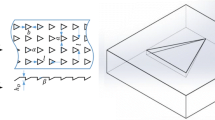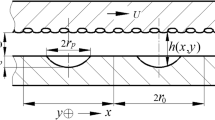Abstract
Hydrodynamic lubrication of rectangular micro-textures on sliding contact surfaces is investigated using numerical calculation methods. The theoretical models for the slider surface are developed and the film pressure is used to evaluate the hydrodynamic lubrication based on the Reynolds equation. Meanwhile, the geometry and distribution of the rectangular dimples are optimized for maximizing the average film pressure. Results show that the film pressure is dependent on the geometry and distribution of the rectangular micro-dimples. The optimal geometry of the single rectangular dimple is obtained, and the spacing has an important influence on the film pressure. The distribution types of rectangular dimples affect the hydrodynamic lubrication significantly and the interlaced array of the rectangular micro-dimples is beneficial to enhancing the hydrodynamic lubrication. Meanwhile, the rectangular dimples with 72° interlaced angle exhibits the best effectivity.














Similar content being viewed by others
Abbreviations
- h 0 :
-
Film thickness
- v :
-
Relative sliding velocity
- a :
-
X-width of single rectangular dimple
- b :
-
Y-width of single rectangular dimple
- d :
-
Depth of rectangular dimples
- φ :
-
Array angle
- l a :
-
X-width of an imaginary rectangular cell (horizontal direction)
- l b :
-
Y-width of an imaginary rectangular cell (vertical direction)
- s x :
-
X-spacing (horizontal direction)
- s y :
-
Y-spacing (vertical direction)
- l x :
-
Distributed width of textures in x direction (horizontal direction)
- l y :
-
Distributed width of textures in y direction (vertical direction)
- ε :
-
Area ratio of single rectangular dimple
- h :
-
Local film thickness
- p :
-
Local film pressure
- η :
-
Dynamic viscosity
- g :
-
Switch function
- θ :
-
Fraction film content
- ρ :
-
Lubricant density
- ρ c :
-
Lubricant density in cavitation zone
- p c :
-
Cavitation pressure
- β :
-
Lubricant bulk modulus
- x :
-
Cartesian coordinate paralleled to the sliding direction
- y :
-
Cartesian coordinate perpendicular to the sliding direction
- p ave :
-
Average film pressure
- w a :
-
Dimensionless reference value of dimple width
- h a :
-
Dimensionless reference value of dimple depth
- P :
-
Dimensionless local film pressure
- H :
-
Dimensionless local film thickness
- D :
-
Dimensionless dimple depth
- H 0 :
-
Dimensionless film thickness
- A :
-
Dimensionless x-width of single rectangular dimple
- B :
-
Dimensionless y-width of single rectangular dimple
- D :
-
Dimensionless depth of rectangular dimples
- L a :
-
Dimensionless x-width of an imaginary rectangular cell (horizontal direction)
- L b :
-
Dimensionless y-width of an imaginary rectangular cell (vertical direction)
- S x :
-
Dimensionless x-spacing (horizontal direction)
- S y :
-
Dimensionless y-spacing (vertical direction)
- L x :
-
Dimensionless distributed width of textures in x direction (horizontal direction)
- L y :
-
Dimensionless distributed width of textures in y direction (vertical direction)
- P c :
-
Dimensionless cavitation pressure
- \( \bar{\beta } \) :
-
Dimensionless lubricant bulk modulus
- X :
-
Dimensionless cartesian coordinate paralleled to the sliding direction
- Y :
-
Dimensionless cartesian coordinate perpendicular to the sliding direction
- s :
-
Number of iterations
- w :
-
Relaxation factor
- E r :
-
Error limit
- P ave :
-
Dimensionless average film pressure
- ξ :
-
Error in polynomial function
References
Wang LL, Guo SH, Wei YL, Yuan GT, Geng H (2019) Optimization research on the lubrication characteristics for friction pairs surface of journal bearings with micro texture. Meccanica 54:1135–1148
Etsion I, Sher E (2009) Improving fuel efficiency with laser surface textured piston rings. Tribol Int 42:542–547
Wang T, Huang WF, Liu XF, Li YJ, Wang YM (2014) Experimental study of two-phase mechanical face seals with laser surface texturing. Tribol Int 72:90–97
Xing YQ, Deng JX, Wang XS, Ehmann KF, Cao J (2016) Experimental assessment of laser textured cutting tools in dry cutting of aluminum alloys. J Manuf Sci Eng-Trans ASME 138(7):071006
Gupta N, Tandon N, Pandey RK (2018) An exploration of the performance behaviors of lubricated textured and conventional spur gearsets. Tribol Int 128:376–385
Hua XJ, Sun JG, Zhang PY, Ge HQ, Fu YH, Ji JH, Yin BF (2016) Research on discriminating partition laser surface micro-texturing technology of engine cylinder. Tribol Int 98:190–196
Xing YQ, Deng JX, Wu Z, Wu FF (2017) High friction and low wear properties of laser-textured ceramic surface under dry friction. Opt Laser Technol 93:24–32
Xing YQ, Wu Z, Yang JJ, Wang XS, Liu L (2020) LIPSS combined with ALD MoS2 nano-coatings for enhancing surface friction and hydrophobic performances. Surf Coat Technol 385:125396
Hu TC, Hu LT, Ding Q (2012) Effective solution for the tribological problems of Ti–6Al–4 V: combination of laser surface texturing and solid lubricant film. Surf Coat Technol 206:5060–5066
Etsion I (2005) State of the art in laser surface texturing. J Tribol Trans ASME 127:248–253
Kumar V, Sharma SC (2018) Influence of dimple geometry and micro-roughness orientation on performance of textured hybrid thrust pad bearing. Meccanica 53:3579–3606
Wang W, He YY, Zhao J, Mao JY, Hu YT, Luo JB (2020) Optimization of groove texture profile to improve hydrodynamic lubrication performance: theory and experiments. Friction 8(1):83–94
Gong JY, Jin Y, Liu ZL, Jiang H, Xiao MH (2019) Study on influencing factors of lubrication performance of water-lubricated micro-groove bearing. Tribol Int 129:390–397
Liu WL, Ni HJ, Wang P, Chen HL (2020) Investigation on the tribological performance of micro-dimples textured surface combined with longitudinal or transverse vibration under hydrodynamic lubrication. Int J Mech Sci 174:105474
Ibatan T, Uddin MS, Chowdhury MAK (2015) Recent development on surface texturing in enhancing tribological performance of bearing sliders. Surf Coat Technol 272:102–120
Nakano M, Korenaga A, Korenaga A, Miyake K, Murakami T, Ando Y, Usami H, Sasaki S (2007) Applying micro-texture to cast iron surfaces to reduce the friction coefficient under lubricated conditions. Tribol Lett 28:131–137
Gropper D, Wang L, Harvey TJ (2016) Hydrodynamic lubrication of textured surfaces: a review of modeling techniques and key findings. Tribol Int 94:509–529
Wang XL, Kato K, Adachi K, Aizawa K (2003) Loads carrying capacity map for the surface texture design of SiC thrust bearing sliding in water. Tribol Int 36:189–197
Costa HL, Hutchings IM (2007) Hydrodynamic lubrication of textured steel surfaces under reciprocating sliding conditions. Tribol Int 40:1227–1238
Nanbu T, Ren N, Yasuda Y, Zhu D, Wang Q (2018) Micro-Textures in concentrated conformal-contact lubrication: effects of texture bottom shape and surface relative motion. Tribol Lett 29:241–252
Ji JH, Guan CW, Fu YH (2018) Effect of micro-dimples on hydrodynamic lubrication of textured sinusoidal roughness surfaces. Chin J Mech Eng 31:67
Uddin MS, Ibatan T, Shankar S (2017) Influence of surface texture shape, geometry and orientation on hydrodynamic lubrication performance of plane-to-plane slider surfaces. Lubr Sci 29:153–181
Kango S, Singh D, Sharma RK (2012) Numerical investigation on the influence of surface texture on the performance of hydrodynamic journal bearing. Meccanica 47:469–482
Cupillard S, Glavatskih S, Cervantes MJ (2008) Pressure build up mechanism in a textured inlet of a hydrodynamic contact. J Tribol 130(2):97–107
Wang XY, Shi LP, Dai QW, Huang W, Wang XL (2018) Multi-objective optimization on dimple shapes for gas face seals. Tribol Int 123:216–223
Pettersson U, Jacobson S (2003) Influence of surface texture on boundary lubricated sliding contacts. Tribol Int 36:857–864
Mao B, Siddaiah A, Menezes PL, Liao YL (2018) Surface texturing by indirect laser shock surface patterning for manipulated friction coefficient. J Mater Process Technol 257:227–233
Zhang H, Hua M, Dong G-N, Zhang D-Y, Chin K-S (2016) A mixed lubrication model for studying tribological behaviors of surface texturing. Tribol Int 93:583–592
Papadopoulos CI, Kaiktsis L, Fillon M (2014) Computational fluid dynamics thermohydrodynamic analysis of three-dimensional sector-pad thrust bearings with rectangular dimples. J Tribol Trans ASME 136:011702
Han YX, Fu YH (2018) Investigation of surface texture influence on hydrodynamic performance of parallel slider bearing under transient condition. Meccanica 53:2053–2066
Liu WL, Ni HJ, Chen HL, Wang P (2019) Numerical simulation and experimental investigation on tribological performance of micro-dimples textured surface under hydrodynamic lubrication. Int J Mech Sci 163:105095
Zhang YL, Zhang XG, Wu TH, Xie YB (2016) Effects of surface texturing on the tribological behavior of piston rings under lubricated conditions. Ind Lubr Tribol 68(2):158–169
Grewal HS, Pendyala P, Shin H, Cho I-J, Yoon E-S (2017) Nanotribological behavior of bioinspired textured surfaces with directional characteristics. Wear 384:151–158
Lu P, Wood RJK, Gee MG, Wang L, Pfleging W (2016) The friction reducing effect of square-shaped surface textures under lubricated line-contacts-an experimental study. Lubricants 4:26
Dobrica MB, Fillon M, Pascovici MD, Cicone T (2010) Optimizing surface texture for hydrodynamic lubricated contacts using a mass-conserving numerical approach. Proc Inst Mech Eng 224:737–750
Etsion I (2013) Modeling of surface texturing in hydrodynamic lubrication. Friction 1(3):195–209
Ji JH, Fu YH, Bi QS (2014) Influence of geometric shapes on the hydrodynamic lubrication of a partially textured slider with micro-grooves. J Tribol Trans ASME 136:041702
Yu HW, Wang XL, Zhou F (2010) Geometric shape effects of surface texture on the generation of hydrodynamic pressure between conformal contacting surfaces. Tribol Lett 37:123–130
Elrod HG (1981) A cavitation algorithm. J Lubr Technol Trans ASME 103(3):350–354
Qiu Y, Khonsari MM (2009) On the prediction of cavitation in dimples using a mass-conservative algorithm. J Tribol Trans ASME 131:041702
Gerald CF, Wheately PO (1994) Applied numerical analysis, 5th edn. Addison-Wesley Publishing Co., New York
Scott LR (2011) Numerical analysis. Princeton University Press, New Jersey
Venner CH, Lubrecht AA (2000) Multigrid techniques: a fast and efficient method for the numerical simulation of elastohydrodynamically lubricated point contact problems. Proc Inst Mech Eng Part J J Eng Tribol 214:43–62
Montgomery DC (2000) Design and Analysis of Experiments, 5th edn. Wiley, New York
Fu H, Ji JH, Fu YH, Hua XJ (2018) Influence of donut-shaped bump on the hydrodynamic lubrication of textured parallel sliders. J Tribol-Trans ASME 140:041706
Adjemout M, Brunetiere N, Bouyer J (2016) Numerical analysis of the texture effect on the hydrodynamic performance of a mechanical seal. Surf Topogr Metrol Prop 4:014002
Shen C, Khonsari MM (2015) Numerical optimization of texture shape for parallel surfaces under unidirectional and bidirectional sliding. Tribol Int 82:1–11
Etsion I, Burstein L (1996) A model for mechanical seals with regular microsurface structure. Tribol Trans 39:677–683
Ren N, Nanbu T, Yasuda Y, Zhu D, Wang Q (2007) Micro textures in concentrated-conformal-contact lubrication: effect of distribution patterns. Tribol Lett 28:275–285
Zhang H, Liu Y, Hua M, Zhang D-Y, Qin L-G, Dong G-N (2018) An optimization research on the coverage of micro-textures arranged on bearing sliders. Tribol Int 128:231–239
Acknowledgements
This work is supported by the Natural Science Foundation of Jiangsu Province (BK20170676), China; National Natural Science Foundation of China (52075097, 51775105); the Technology Foundation for the Selected Returned Overseas Chinese Scholars in Nanjing (1102000219), China; and the Zhishan Young Scholar Foundation of Southeast University, China (2242020R40111), China. The authors would also like to thank the Advanced Manufacturing Processes Laboratory in Northwestern University (USA).
Author information
Authors and Affiliations
Corresponding authors
Ethics declarations
Conflict of interest
The authors declare that they have no conflict of interest.
Additional information
Publisher's Note
Springer Nature remains neutral with regard to jurisdictional claims in published maps and institutional affiliations.
Rights and permissions
About this article
Cite this article
Xing, Y., Li, X., Hu, R. et al. Numerical analyses of rectangular micro-textures in hydrodynamic lubrication regime for sliding contacts. Meccanica 56, 365–382 (2021). https://doi.org/10.1007/s11012-020-01296-x
Received:
Accepted:
Published:
Issue Date:
DOI: https://doi.org/10.1007/s11012-020-01296-x




